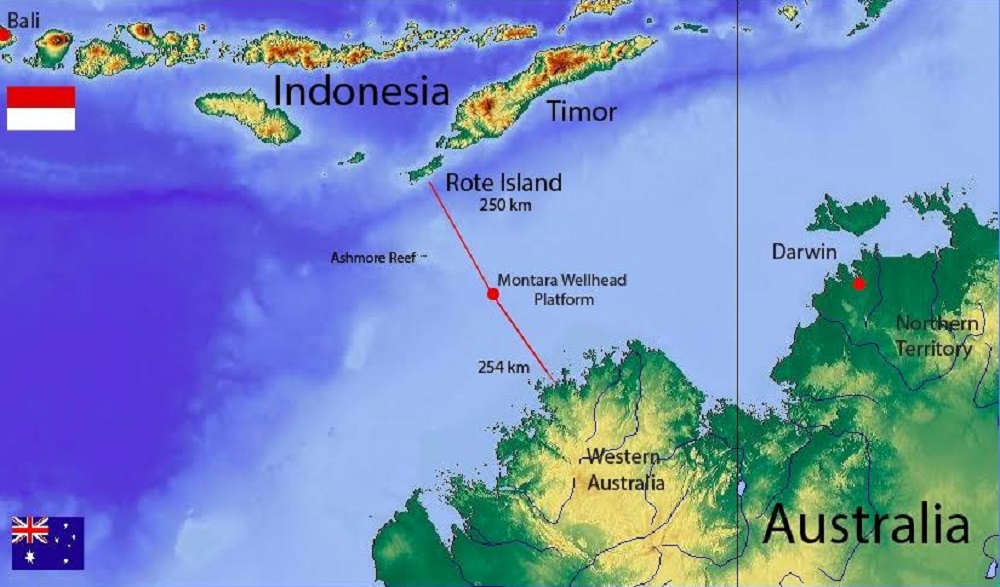- The lawsuit follows a meeting in March between Luhut Pandjaitan, Indonesia’s coordinating maritime minister, and Julie Bishop, Australia’s foreign minister.
- It also comes on the heels of a class-action suit brought by 15,000 Indonesian seaweed farmers against the firm in Australian court.
- The company maintains it has seen no evidence of damage from the spill in Indonesian waters.
- NGOs are calling on all sides to form a joint task force to establish once and for whether such damage occurred.
JAKARTA — Indonesia is suing an arm of Thailand’s biggest energy group, PTT, for the equivalent of more than $2 billion over a 2009 oil spill the archipelago country says damaged its environment and the health and livelihoods of local people.
For the first time in the marine realm, the Indonesian Ministry of Environment and Forestry has invoked the principle of strict liability, previously used to hold plantation firms accountable for fires that occur on land they control.

Last month, palm oil and paper industry lobby groups filed their own lawsuit with Indonesia’s highest court, asking it to abolish the concept of strict liability from the nation’s forestry and environment laws, although the business associations subsequently withdrew the suit, claiming they needed more time to study the rules.
“This is a first for marine issues because we’re mostly dealing with forest fires,” said Jasmin Ragil Utomo, the ministry’s dispute settlement director. “But we are more than ready.”
Indonesia’s lawsuit against the state-owned oil and gas giant comes eight years after a leak in the Montara offshore drilling platform it operated gushed tens of thousands of barrels of oil into the Timor Sea, a body of water shared by Australia and Indonesia. While the firm admits that oil from the spill reached Indonesian waters, and acknowledges that “mistakes were made that should never be repeated,” it continues to maintain it has seen no evidence that the spill caused harm to Indonesia’s environment. Negotiations between the two sides broke down four years ago.
The lawsuit follows a meeting in March between coordinating maritime minister Luhut Pandjaitan and Australian foreign minister Julie Bishop at which the spill was discussed.
“It has been a long time but that does not mean they are not accountable [for the damages],” said deputy coordinating maritime minister Arief Havas Oegroseno, who is working closely with the environment ministry on the case.

Indonesian observers are calling for all sides in the dispute — the Indonesian and Australian governments, regional administrations, affected local people and the company — to form a joint task force to determine once and for all the extent of the damage in Indonesia.
“If each party does its own research, the others will just reject it,” said Mukhtasor, an ocean engineering professor at Sepuluh Nopember Institute of Technology, who like many Indonesians goes by one name. “If there’s a joint team, then the case can be settled.”
The idea was proposed to Pandjaitan after his meeting with Bishop, although it has been floated for years, said Ferdi Tanoni, a member of the West Timor Care Foundation, an NGO advocating for people affected by the spill.
More than 15,000 seaweed farmers have also filed a class-action lawsuit against the company in an Australian court, seeking compensation for loss of livelihoods due to faltering seaweed production and allegations of severe health problems.
In the deputy coordinating minister’s view, Indonesia already has enough evidence. “We had a team and they did their part,” Oegroseno said. “So we’re focusing on the court process.”
Banner image: The Montara platform seen from the air on Sept. 12, 2009, two weeks after the spill began. Oil slicks around platform are clearly visible; the white haze is a spray of water vapor, natural gas, and natural gas condensate from the uncontrolled well. Photo courtesy of Environs Kimberley/Flickr.
FEEDBACK: Use this form to send a message to the author of this post. If you want to post a public comment, you can do that at the bottom of the page.
